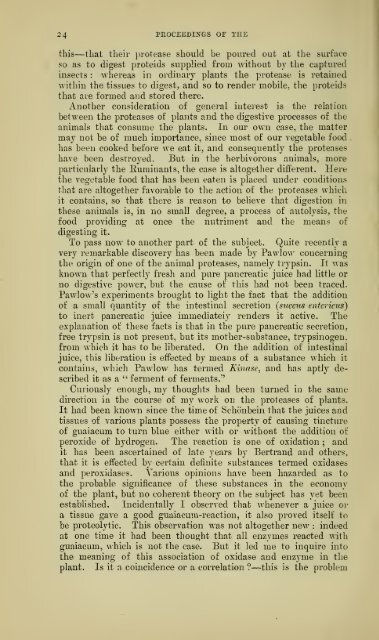Proceedings of the Linnean Society of London - University Library
Proceedings of the Linnean Society of London - University Library
Proceedings of the Linnean Society of London - University Library
Create successful ePaper yourself
Turn your PDF publications into a flip-book with our unique Google optimized e-Paper software.
2 4<br />
PROCEEDINGS OF THE<br />
this—that <strong>the</strong>ii' protease should be poiu'ed out at <strong>the</strong> surface<br />
so as to digest proteids supplied from without by <strong>the</strong> captured<br />
insects : Avhereas in ordiuary plants <strong>the</strong> protease is retained<br />
within <strong>the</strong> tissues to digest, and so to render mobile, <strong>the</strong> proteids<br />
that are formed and stored <strong>the</strong>re.<br />
Ano<strong>the</strong>r consideration <strong>of</strong> general interest is <strong>the</strong> relation<br />
between <strong>the</strong> proteases <strong>of</strong> plants and <strong>the</strong> digestive processes <strong>of</strong> <strong>the</strong><br />
animals that consume <strong>the</strong> plants. In our own case, <strong>the</strong> matter<br />
may not be <strong>of</strong> much importance, since most <strong>of</strong> our vegetable food .<br />
has been cooked before we eat it, and consequently <strong>the</strong> proteases<br />
have been destroyed. But in <strong>the</strong> herbivorous animals, more<br />
particularly <strong>the</strong> Ruminants, <strong>the</strong> case is altoge<strong>the</strong>r different. Here<br />
<strong>the</strong> vegetable food that has been eaten is placed under conditions<br />
that are altoge<strong>the</strong>r favorable to <strong>the</strong> action <strong>of</strong> <strong>the</strong> proteases which<br />
it contains, so that <strong>the</strong>re is reason to believe that digestion in<br />
<strong>the</strong>se animals is, in no small degree, a process <strong>of</strong> autolysis, <strong>the</strong><br />
food providing at once <strong>the</strong> nutriment and <strong>the</strong> means <strong>of</strong><br />
digesting it.<br />
To pass now to ano<strong>the</strong>r part <strong>of</strong> <strong>the</strong> subject. Quite recently a<br />
very remarkable discovery has been made by Pawlow concerning<br />
<strong>the</strong> origin <strong>of</strong> one <strong>of</strong> <strong>the</strong> animal proteases, namely trypsin. It "s^as<br />
known that perfectly fresh and pure pancreatic juice had little or<br />
no digestive power, but <strong>the</strong> cause <strong>of</strong> this had not been traced.<br />
Pawlou 's experiments brought to light <strong>the</strong> fact that <strong>the</strong> addition<br />
<strong>of</strong> a small quantity <strong>of</strong> <strong>the</strong> intestinal secretion (snccus tntericus)<br />
to inert pancreatic juice immediately renders it active. The<br />
explanation <strong>of</strong> <strong>the</strong>se facts is that in <strong>the</strong> pure pancreatic secretion,<br />
free trypsin is not present, but its mo<strong>the</strong>r-substance, trypsinogen,<br />
from which it has to be liberated. On <strong>the</strong> addition <strong>of</strong> intestinal<br />
juice, this liberation is effected by means <strong>of</strong> a substance which it<br />
contains, which Pawlow has termed Kinase^ and has aptly de-<br />
scribed it as a " ferment <strong>of</strong> ferments.''<br />
Curiously enough, my thoughts had been turned in <strong>the</strong> same<br />
direction in <strong>the</strong> course <strong>of</strong> ray work on <strong>the</strong> proteases <strong>of</strong> plants.<br />
It had been known since <strong>the</strong> time <strong>of</strong> Schtinbein that <strong>the</strong> juices and<br />
tissues <strong>of</strong> various plants possess <strong>the</strong> property <strong>of</strong> causing tincture<br />
<strong>of</strong> guaiacum to turn blite ei<strong>the</strong>r with or without <strong>the</strong> addition <strong>of</strong><br />
peroxide <strong>of</strong> hydrogen. The reaction is one <strong>of</strong> oxidation ; and<br />
it has been ascertained <strong>of</strong> late years by Bertrand and o<strong>the</strong>rs,<br />
that it is effected by certain definite substances termed oxidases<br />
and peroxidases. Various opinions have been hazarded as to<br />
<strong>the</strong> probable significance <strong>of</strong> <strong>the</strong>se substances in <strong>the</strong> economy<br />
<strong>of</strong> <strong>the</strong> plant, but no coherent <strong>the</strong>ory on <strong>the</strong> subject has yet been<br />
established. Incidentally I observed that whenever a juice or<br />
a tissue gave a good guaiacura-reaction, it also proved itself to<br />
be proteolytic. This observation was not altoge<strong>the</strong>r new : indeed<br />
at one time it had been thought that all enzymes reacted with<br />
gxiaiacum, whicli is not <strong>the</strong> case. But it led me to inquire into<br />
<strong>the</strong> meaning <strong>of</strong> this association <strong>of</strong> oxidase and enzyme in <strong>the</strong><br />
plant. Is it a coincidence or a correlation ?—this is <strong>the</strong> problem










![Novellen [microform] - University Library](https://img.yumpu.com/21939450/1/171x260/novellen-microform-university-library.jpg?quality=85)
![Anecdota Chisiana de re metrica [microform]](https://img.yumpu.com/21939448/1/190x239/anecdota-chisiana-de-re-metrica-microform.jpg?quality=85)



![Schollenbruch [microform] : Gedichte - University Library](https://img.yumpu.com/21939437/1/174x260/schollenbruch-microform-gedichte-university-library.jpg?quality=85)

